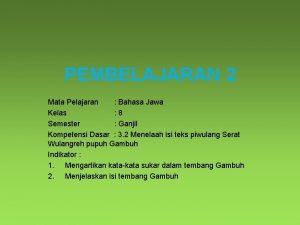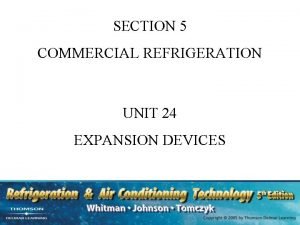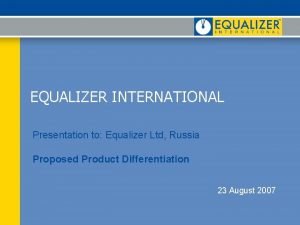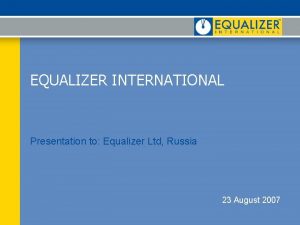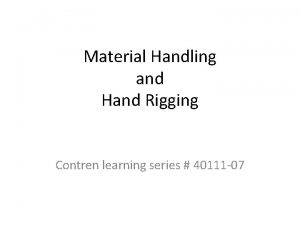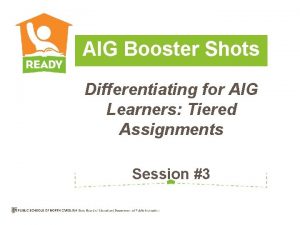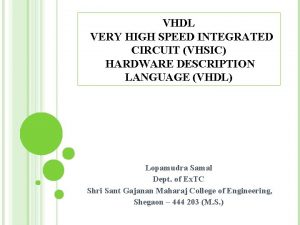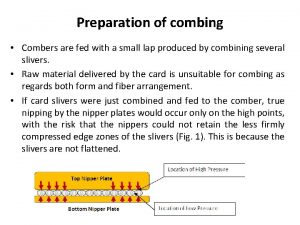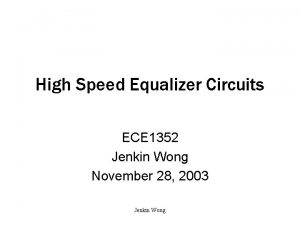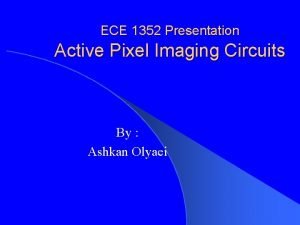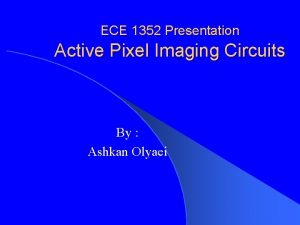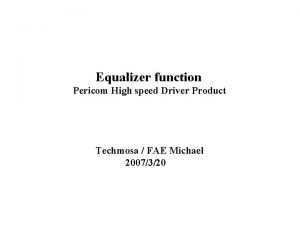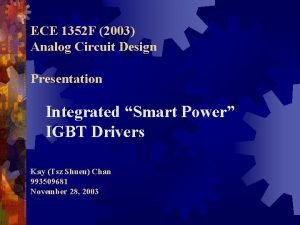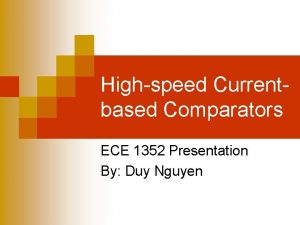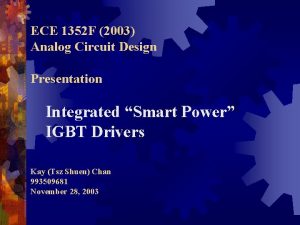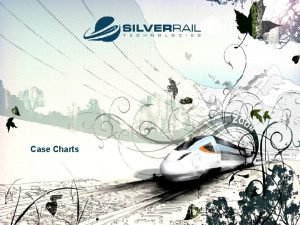High Speed Equalizer Circuits ECE 1352 Jenkin Wong















- Slides: 15

High Speed Equalizer Circuits ECE 1352 Jenkin Wong November 28, 2003 Jenkin Wong

Agenda Background • Why Equalize? Equalization for 100 Base-TX Ethernet • Introduction • Define Problem • Proposed Solution Jenkin Wong 2

Background Why Equalize? • Non-ideal Channel • In frequency domain – Amplitude and Phase attenuation • In time domain – Intersymbol Interference (ISI) Maximize Data Rate on a Bandlimited Channel Jenkin Wong 3

Equalizer for 10 Mb/s and 100 Mb/s Ethernet Background • A CMOS Transceiver for 10 Mb/s and 100 Mb/s Ethernet by Everitt, Parker, Hurst, Nack and Konda • Uses an Adaptive Equalization scheme implemented in the analog domain • MLT 3 Encoding for 100 Base-TX Focus on 100 Base-TX Jenkin Wong 4

Equalization for 100 Base-TX What are the problems? • Attenuation vs. Frequency characteristic of the CAT-5 Cable, § At 62. 5 MHz, 18 d. B loss after 100 m of cable • Baseline Wander § Worst case is when 56 consecutive zeros (max), followed by 4 ones • DC Insertion Loss of Cable § 2 d. B for 100 m cable Jenkin Wong 5

Equalization for 100 Base-TX Solution • Adaptive Equalizer - Analog Implementation § Combines a coarse ADC and digital algorithms based on signal statistics to achieve equalization Jenkin Wong 6

Equalization for 100 Base-TX Equalization Control • Over-equalized – overshoot at each symbol transition • Under-equalized – Too much high frequency Attenuation Jenkin Wong 7

Equalization for 100 Base-TX Gain and DC wander Control • Too much Gain – always +1 error • Not enough Gain – always – 1 error Jenkin Wong 8

Equalization for 100 Base-TX Adaptive Equalizer Block • Implementation issues § Position of Zero and Poles Digital Logic will § Range of Gm Tune Gm 1 and Gm 2 § Controlling R Jenkin Wong 9

Equalization for 100 Base-TX Transconductance Cell • Used in both the tuning PLL and the LPF • Bias for the LPF Gm cell is copied from the Gm. C cells inside PLL • R = 1/Gm Jenkin Wong 10

Equalization for 100 Base-TX Wander Cancellation Cell • Digital logic controls the charge pump changing the current Icp • Voltage I*R is add to cancel the DC wander Jenkin Wong 11

Equalization for 100 Base-TX Equalization performance at 100 m The Eye is opened Jenkin Wong 12

Equalization for 100 Base-TX Performance Summary Equalization works! Jenkin Wong 13

Equalization for 100 Base-TX Conclusion • Crash course on Equalization • Analog Implementation of a High Speed adaptive equalization scheme for 100 Base-TX • Equalization is one of the many keys to reliable high speed digital data communication • ECE 1392 – IC for Digital Communication • Q&A Jenkin Wong 14

Equalization for 100 Base-TX References • A CMOS Transceiver for 10 Mb/s and 100 Mb/s Ethernet by Everitt, Parker, Hurst, Nack and Konda • A Mixed-Signal Tuning Loop for Variable Bandpass Filter, A Final Report by Wee-Guan Ben Tan, EE, University of California • Slides from Research Overview in Analog IC Design by Prof. Phillip E. Allen, ECE Georgia Institute of Technology • Notes from Analog versus DSP for Disk Drive by Prof. Richard Spencer, University of California Jenkin Wong 15
 Tegese kebanjur yaiku
Tegese kebanjur yaiku A narrow field of vision (140 degrees or less) is called...
A narrow field of vision (140 degrees or less) is called... Advantages of parallel circuits over series circuits
Advantages of parallel circuits over series circuits External equalizer expansion valve
External equalizer expansion valve Tripoding in prosthodontics definition
Tripoding in prosthodontics definition Asc 52 attachment
Asc 52 attachment Equalizer world slides
Equalizer world slides Equalizer international flange tools
Equalizer international flange tools Tripod clasping
Tripod clasping Equalizer beam rigging
Equalizer beam rigging Tomlinson's equalizer
Tomlinson's equalizer Education is the great equalizer meaning
Education is the great equalizer meaning Speed time and distance formula
Speed time and distance formula Speed detection of moving vehicle using speed cameras
Speed detection of moving vehicle using speed cameras Vhsic
Vhsic High speed combers
High speed combers
